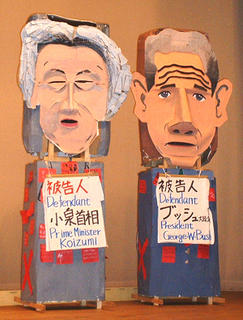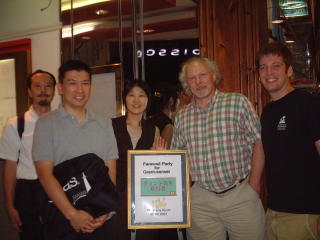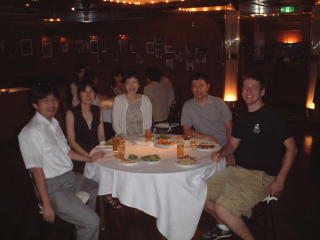Rotten beans
 Despite all the talk of Japan being difficult for a vegetarian, there are a few traditional restaurants that serve only tofu concoctions. The kanji for "tofu" (above) literally means "rotten beans," though this is a butchered translation. The first kanji--"to"--can also be pronounced "mame" (as in "edamame") and refers specifically to soybeans. The second kanji--"fu"--means, for lack of a more appetizing word, "rotten," but a better translation would probably be fermented. Many Japanese dishes are made from soybeans fermented or "rotted" in some form. Miso (the paste used in miso soup) is actually ground soybeans mixed with salt and mold culture and canned for close to three years. Natto is--well, natto is actually literally rotten soybeans, often mixed with raw egg. So anyway, this particular tofu restaurant's chef grows his own crop of mame on the outskirts of Hiroshima, and he makes his own miso, tonyu (soy milk, but with more of a tofu flavor), tofu, and various other traditional tofu dishes whose names escape me. A dinner set typically comes with miso, tonyu, plain tofu, agetofu (battered and quickly deep fried), ground soybean paste with ginger and garlic, mashed tofu with edamame beans, rice, and soy ice cream for desert.
Despite all the talk of Japan being difficult for a vegetarian, there are a few traditional restaurants that serve only tofu concoctions. The kanji for "tofu" (above) literally means "rotten beans," though this is a butchered translation. The first kanji--"to"--can also be pronounced "mame" (as in "edamame") and refers specifically to soybeans. The second kanji--"fu"--means, for lack of a more appetizing word, "rotten," but a better translation would probably be fermented. Many Japanese dishes are made from soybeans fermented or "rotted" in some form. Miso (the paste used in miso soup) is actually ground soybeans mixed with salt and mold culture and canned for close to three years. Natto is--well, natto is actually literally rotten soybeans, often mixed with raw egg. So anyway, this particular tofu restaurant's chef grows his own crop of mame on the outskirts of Hiroshima, and he makes his own miso, tonyu (soy milk, but with more of a tofu flavor), tofu, and various other traditional tofu dishes whose names escape me. A dinner set typically comes with miso, tonyu, plain tofu, agetofu (battered and quickly deep fried), ground soybean paste with ginger and garlic, mashed tofu with edamame beans, rice, and soy ice cream for desert.In other news, here I am rocking the yukata I wear around every day after work.

Finally, here is a good overview of Japanese postal privatization in the context of the upcoming elections.



















































